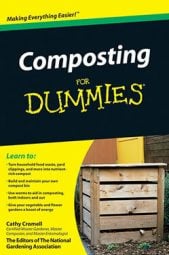One inexpensive option for making your own compost container is to use a large, recycled garbage can. Contact the department responsible for trash pickup (it may be called solid waste disposal) in your area, whether it be a town, city, county, or other office. Many communities recycle their no-longer-useable garbage cans as compost containers to residents, either free or for a nominal fee. You may want to gather a group of neighbors (including someone with a truck) to pick up several at once.
Check with these same municipal departments (or the Council departments in the United Kingdom) to see whether they offer reduced prices on manufactured compost containers. Some may offer promotions (even free manufactured containers) to encourage community involvement in composting, recycling, and waste reduction.
Garbage can styles vary, of course. Some come with secure lids, which is great if you want to keep pests out. Most agencies have already removed any wheels on the can. Some may remove the bottom of the trash can and/or punch aeration holes. If you have a preference for bottom/no bottom or holes/no holes, ask in advance to see whether your request can be accommodated.
Using recycled garbage cans as composting bins has upsides and downsides:
Advantages
Cost: They're free or inexpensive.
Portability: They're easy to move to different areas in the garden.
Protection from pests: Cans with lids keep pests at bay.
Disadvantages
Size and shape: Most garbage cans aren't quite large enough to contain the optimal amount of organic matter (1 cubic yard or 1 cubic meter) needed to self-insulate and promote fast decomposition.
Appearance: With apologies to Gertrude Stein, a garbage can is a garbage can is a garbage can. Let your kids loose on it with some paints and brushes to dress it up a bit, or hide the can in the back corner of your landscape!
The great thing about this compost bin project is that it requires so little — a recycled garbage receptacle obtained from your municipality. If this isn't an option where you live, you may check with neighbors or put an advertisement in your local paper or on Web sites asking to recycle a can someone is tossing.
Not surprisingly, lifting or moving the bin into position is the most challenging part of erecting a recycled garbage can compost bin. You just set your can in place and start filling it up. (Wasn't that easy?
If your can comes with a lid but no bottom and you want to keep pests at bay, dig a hole about 1 foot (0.3 meters) deep and "sink" the base of the container into the soil.
If your can has no lid, no bottom, and is wider at the top, the narrowing shape makes it somewhat more difficult to aerate the organic matter at the bottom when stirring with a compost fork or aeration tool. Setting the can upside down so the wider section becomes the base alleviates this issue. When it's time to turn the material, lift it up, set it aside, and fork the materials back into it. When choosing a site for your composting, allow sufficient space to set the can to the side, and you'll save labor in the long run.

